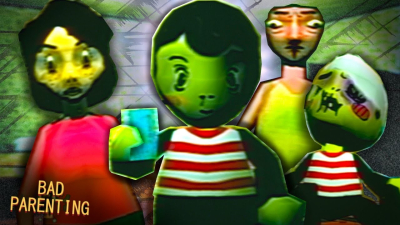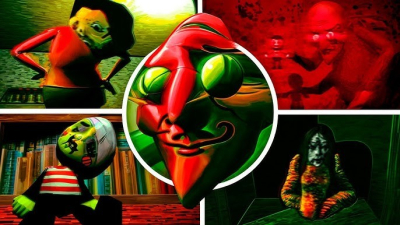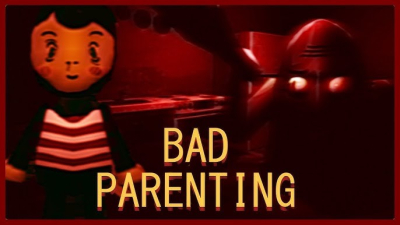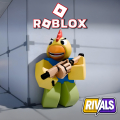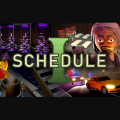Bad Parenting
When I first booted up Bad Parenting 1: Mr. Red Face, I was filled with a mix of curiosity and excitement for a game that promised a unique blend of mischievous humor and unconventional challenges. From the outset, I found the experience both refreshing and compelling, challenging the typical narrative of parenting simulations by embracing chaos in a humorously dark fashion. Playing from a first-person perspective gave me a direct insight into the eccentric world of Mr. Red Face, a character whose actions and decisions set the tone for absurdity and vibrant gameplay. My adventure into this pixelated universe was not just about managing a fictional household but rather about exploring the hidden layers of game design that make every decision impactful in unexpected ways.
Exploring the Unorthodox Gameplay Mechanics
In my playthrough, I discovered that the game’s mechanics are anything but typical. The gameplay is structured around a series of unconventional tasks where the objective is to maneuver through the chaotic life of a difficult parent. Every action I undertook was wrapped in intricate layers of satire and irony which both amused and frustrated me. The developers have implemented a dynamic system whereby my decisions directly affected the behavior of non-playable characters and the evolving game environment. I found that understanding the mechanics required me to think creatively, making me consider each whim and impulse in a way that could lead to unexpected rewards or setbacks. This interactive narrative style challenged the standard notions of parenting games and encouraged players to experiment without fear of traditional failure modes.
Unraveling the Storyline and Narrative Style
The plot of Bad Parenting 1: Mr. Red Face is as unconventional as the gameplay itself. As I navigated through the narrative, I encountered a storyline filled with absurd scenarios, ironic twists, and a rich tapestry of dark humor. The narrative embraced a fragmented approach that allowed each scene to reveal a piece of the bizarre life of Mr. Red Face while also hinting at deeper societal critiques hidden in playful banter. I appreciated how the storyline was interlaced with subtle commentary on modern life and the challenges of balancing personal desires with the responsibilities of raising children. The experience of following a non-linear story in which every decision seemed almost accidental yet pivotal added an element of suspense throughout my entire adventure.
Immersive Character Design and Personal Transformation
One of the highlights of my experience was the surprising depth afforded to Mr. Red Face and the supporting cast. The character design in the game succeeded in bringing to life a protagonist who is both flawed and endearing in a satirical way. I was particularly struck by the way my decisions as a player influenced not only the external environment but also subtly shifted the personality and motivations of Mr. Red Face over time. This evolution felt organic and rewarding, as if my choices were carving out a unique narrative journey. The character interactions were laced with dark humor, and each conversation or encounter left me pondering the sometimes absurd reality of parental responsibilities viewed through the lens of satire.
Engaging and Unpredictable Level Design
The level design in Bad Parenting 1: Mr. Red Face is a masterclass in unpredictability. Every level presented a new setting with its own set of challenges that required me to adapt and strategize on the fly. I found that the design was both imaginative and brutal in its honesty, reflecting the real-life chaos of parenting but with a twist of surrealism. The environments were crafted in a manner that reflected both the internal turmoil of the protagonist and the external absurdities of everyday life. Whether navigating cluttered house interiors or surreal, dream-like neighborhoods, the game constantly kept me on my toes, rewarding exploration and clever problem-solving while also surprising me with unexpected obstacles and quirky characters.
Visual and Aesthetic Brilliance
From a purely visual standpoint, the aesthetic choices in Bad Parenting 1: Mr. Red Face left a lasting impression on me. The game utilizes a distinctive art style that merges cartoonish elements with dark, gritty undertones. I particularly enjoyed the way colors were used to convey mood and atmosphere; vibrant hues would frequently clash with muted backgrounds, enhancing the feeling of constant internal conflict and comedic disarray. The hand-crafted animations and meticulous character designs provided a visual narrative that enhanced the overall thematic depth. I spent a considerable amount of time appreciating the tiny details in each frame, from the expressive facial animation of Mr. Red Face to the elaborately drawn everyday objects that populated the game world.
Immersive Audio and Soundtrack Design
The auditory dimension of the game deserves special mention as it played a crucial role in drawing me deeper into the experience. I found the soundtrack to be an eclectic mix of quirky tunes and ambient sounds that precisely matched the ever-changing emotional landscape of the game. The developers have done an excellent job of weaving sound effects into the gameplay, ensuring that each action—whether it was a minor gesture or a significant plot twist—was given weight with impeccable audio cues. The voice acting, particularly, conveyed the essence of each character so that even brief interludes felt rich with personality and sarcasm. Each musical note and sound effect was intricately linked to the unfolding narrative, providing contextual clues and reinforcing the game’s distinct ambiance.
Innovative Management of In-Game Resources
Resource management in Bad Parenting 1: Mr. Red Face is presented in a whimsically challenging manner. I was intrigued by how the game incorporated the familiar mechanics of balancing resources—ranging from time to energy—within a chaotic and unpredictable scenario. Unlike traditional simulations, the focus was not merely on efficiency but rather on embracing the sometimes arbitrary nature of managing a household under eccentric circumstances. This forced me to rethink conventional strategies about planning and prioritization. Every choice I made by investing resources in one direction often left unexpected gaps in another, echoing the real-life challenges of unpredictable caregiving. This dynamic often led to a sense of urgency and creative problem-solving, making every decision count in a way that few other games have managed to capture.
Complexity and Depth in Gameplay Decisions
As I advanced further into the game, I appreciated the multitude of decisions that shaped the character and storyline in profound ways. Every interaction was imbued with complexity, demanding careful thought even when the overall narrative was steeped in absurdity. I realized that the game deliberately blurred the lines between consequence and chaos, pushing me to weigh the cost of each reckless action against potential rewards. This depth in the decision-making process elevated my engagement, as even seemingly trivial actions had the potential to ripple through the story in unexpectedly meaningful ways. The layers of choices challenged me to balance personal satisfaction with the betterment of the overall game experience, a paradox that neatly encapsulated the balancing act inherent in the lives of the game’s characters.
Satirical Social Commentary Through Gameplay
One of the aspects I found particularly clever about Bad Parenting 1: Mr. Red Face was its use of satire to comment on societal norms and expectations. The game constantly pried open the usually polished veneer of conventional family life to reveal the underlying chaos, all done with an irreverent sense of humor that both entertained and provoked thought. As I navigated the bizarre scenarios that the game presented, I recognized subtle critiques of modern societal pressures, expectations, and the often unrealistic portrayals of familial bliss. The humorous jabs and ironic twists were not only entertaining but also served as a mirror reflecting the sometimes absurd reality of everyday norms. This subtle social commentary added an enriching layer of depth, making me appreciate the game not solely as a simulation but as a creative critique of societal constructs.
Unpredictable Challenges and Interactive Puzzles
The journey through Bad Parenting 1: Mr. Red Face was punctuated by numerous puzzles and challenges that kept me engaged and constantly guessing. These interactive elements were designed to mimic the unpredictability of real-life scenarios, albeit in an exaggerated, tongue-in-cheek manner. I encountered puzzles that required a mix of abstract thought and reflexive decision-making, often combining physical spatial challenges with mental puzzles. Each scenario was crafted to ensure that there was a fine balance between humor and challenge. I remember a particularly intricate puzzle that required me to sequence household chores in a way that seemed nonsensical yet had a hidden logic behind it. These segments not only tested my problem-solving abilities but also served to keep me on the brink of surprise throughout the entire playthrough.
Emotional Resonance in an Absurd World
Despite the overt humor and chaotic gameplay experiences, I was surprised at the emotional resonance that emerged gradually throughout the game. There were moments when the absurdity of the situation belied an underlying commentary on familial bonds and personal responsibility. In the midst of bizarre challenges, I discovered layers of vulnerability within Mr. Red Face’s character that added a rich, human dimension to his struggles. Through candid moments of introspection juxtaposed with wild antics, the game managed to evoke genuine emotions that made me reflect upon the messy realities of human relationships. Although the narrative maintained its satirical edge, the interludes of delicate vulnerability offered a surprising depth that made the entire experience both entertaining and thought-provoking.
Dynamic Interactions and Community of Characters
Another captivating element was the sheer variety of characters that populated the world of Bad Parenting 1: Mr. Red Face. From quirky neighbors to eccentric family members, each character brought a unique vibrancy to the overall experience. I found that the interactions were designed in such a way that they felt organic rather than scripted, allowing me to immerse myself fully in the game’s sprawling social landscape. Conversations were laced with quick-witted humor and unexpected turns that added a dynamic layer to the unfolding events. The diversity of personalities not only enriched the narrative but also provided me with multiple perspectives on the absurd challenges of daily life. Engaging with these characters felt like participating in a sprawling social experiment, where every dialogue contributed to an evolving story that was as unpredictable as it was engaging.
Innovative Functionality and User Interface Design
The functionality of the game is another aspect that truly captured my admiration. The user interface, though unorthodox, strikes a delicate balance between providing essential information and immersing players in the portrayal of chaos. I found that the controls were both intuitive and deliberately quirky, reinforcing the game’s overall theme of unpredictability in a playful manner. Navigating through menus and accessing various in-game tools felt like an extension of the narrative itself. The developers managed to integrate often-overlooked details into the interface, ensuring that every element—from the arrangement of icons to the transitions between screens—was meticulously crafted to echo the central themes of nonconformity and unexpected cycles of reality. This thoughtful design contributed significantly to my seamless yet adventurous gaming experience, highlighting the innovative nature of its development.
Interactive Humor and Every Decision’s Impact
The hallmark of my experience in Bad Parenting 1: Mr. Red Face has been the game’s masterful blend of interactive humor with strategic depth. Every choice I made resonated with humor that was as clever as it was surprising. Whether I opted to casually ignore certain conventions of responsibility or actively pursue a wildly unorthodox course of action, the game rewarded my engagement with unpredictable results. It was fascinating to see how minor actions created ripples of humorous consequences that cascaded throughout the game. The iterative feedback loop between my decisions and the unfolding narrative kept me entertained and deeply invested, offering a gamer's delight in discovering just how much impact a seemingly minor choice could have. This element of the gameplay transformed what might have been simple mechanics into an intricate dance of cause and effect, all wrapped in a layer of satirical wit that continuously kept my adrenaline high.
Pros
- Unique and innovative gameplay mechanics that merge interactive humor with strategic depth
- Clever integration of dark satire that challenges traditional narratives in parenting simulations
- Visually striking aesthetics that combine cartoonish elements with dark, gritty undertones
- Rich character development where player choices shape the evolution of the protagonist
- Dynamic level design offering unexpected challenges and engaging puzzles
- Intuitive user interface and immersive audio design that reinforce the chaotic atmosphere
Cons
- Unconventional mechanics may overwhelm players used to traditional simulation games
- Occasional unpredictable difficulty spikes in puzzles that affect the flow of gameplay
- The heavy emphasis on chaotic themes might not appeal to those seeking a more structured narrative
To download the app, you will get links to the Official Website and/or official digital markets.
